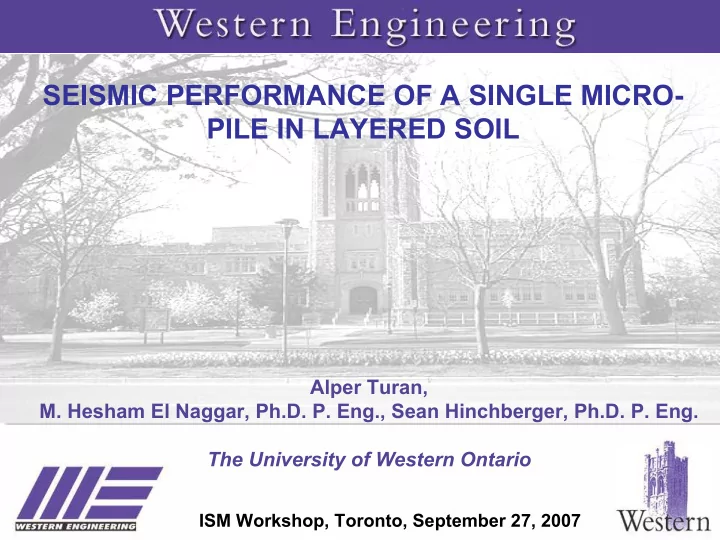

SEISMIC PERFORMANCE OF A SINGLE MICRO- PILE IN LAYERED SOIL Alper Turan, M. Hesham El Naggar, Ph.D. P. Eng., Sean Hinchberger, Ph.D. P. Eng. The University of Western Ontario ISM Workshop, Toronto, September 27, 2007
1 INTRODUCTION Finite element analyses of seismic response of a single micro-pile performed considering soil nonlinearity. Factors Considered: • soil plasticity • Soil layering • input motion intensity • pile casing termination • Boundary conditions
2 Modelling • The soil and pile were modelled using 4-noded linear tetrahedron elements with three degrees of freedom in each node. • Transmitting boundaries (Wolf and Song, 1996) are used to allow for wave propagation.
3 Predominant Period = 0.16 sec. Peak Acceleration=3 m/s2 Peak Acceleration=1 m/s2 4 Peak Acceleration=5 m/s2 Acceleration (m/s2) 2 0 -2 A Ricker wavelet 0.0 0.5 1.0 1.5 2.0 acceleration with 3 Time(sec) m/s 2 peak amplitude 0.000 and 0.16 sec period is used. -0.001 Displacement (m) -0.002 -0.003 -0.004 -0.005 Peak Displacement=3 m/s2 Peak Displacement=1 m/s2 -0.006 Peak Displacement=5 m/s2 Predominant Period = 0.16 sec. -0.007 0.0 0.5 1.0 1.5 2.0 Time(sec)
4 Verification of Model P static =20 KN Static Dynamic validation Boundary in dynamic Es=Varies Es=4.69 × 10 2 validation Boundary in static MN/m 2 Ep= 2.3×10 MN/m 4 2 D= H=12 Ep= 2.3×10 4 MN/m 2 8m m ν s =0.48 ν s =0.48 ν p =0.30 ν p =0.30 Pile diameter d=0.20 m L=50d ν p =0.30 Ricker Wavelet (Base Acceleration) Static loading 2.5 Elastic solution by Pile Head Deflection (mm) Davies and Budhu (1986) 2.0 3D Finite Elem ent Solution 2D Finite Elem ent Solution 1.5 1.0 0.5 0.0 10 100 1000 Young M odulus (M N/m 2)
5 Model Verification 0.0 06 Lateral Pile Head Deflection (m) 0.0 04 0.0 02 0.0 00 -0.0 02 -0.0 04 -0.0 06 P resent S tudy -0.0 08 Dynamic loading W o n g (20 04)
6 Results and Discussion Effect of Boundary Conditions: Transmitting boundaries by Wolf and Song (1996) performs better in absorbing energy in comparison with rigid, infinite and transmitting boundaries 0.006 Lateral Displacement of Pile Head (m) Linear Elastic Soil and Pile No hysteretic damping 0.004 0.002 0.000 -0.002 -0.004 Quite Boundary ( Lysmer and Kuhlemeyer, 1969)- -0.006 Silent Boundary ( Wolf and Song, 1996)- ζ=2% Rigid Boundary ( at 240d distance)- ζ=2% -0.008 0.6 0.8 1.0 1.2 1.4 1.6 1.8 2.0 Time(sec)
7 Results and Discussion Soil Plasticity: The pile head response decreased due to soil plasticity, particularly evident for strong input motion 14 Linear Elastic - Peak Acc=0.3g Mohr - Coulomb - Acc=0.3g 12 Spectral Acceleration (m/s2) Linear Elastic - Peak Acc=0.5g Mohr - Coulomb - Acc=0.5g 10 8 6 4 2 0 0.1 1 10 100 Frequency (Hz)
8 Results and Discussion Soil layering: Three different soil profiles are considered 0.0 0.2 Normalized Pile Depth 0.4 0.6 Peak Acceleration=0.5g 0.8 Case 1 Case 2 Case 3 1.0 0 1 2 3 4 5 6 Bending Moment (KNm)
9 Results and Discussion Casing Termination During Construction: Significantly higher bending moments can occur at the point where casing is terminated. 0.0 No Casing Termination Casing Termination at 1/3 of the Pile 0.2 Normalized Pile Depth Peak Acceleration=0.5g 0.4 0.6 0.8 1.0 -0.5 0.0 0.5 1.0 1.5 2.0 2.5 Bending Moment (KNm)
10 CONCLUSIONS Transmitting boundaries should be used in modelling problems involving dynamic loading. However, consistent boundaries, which simulate the stiffness of the soil extending to the infinity, should be used for more realistic analyses. Considering soil nonlinearity leads to more realistic response, resulting in 40 % reduction of the spectral acceleration of the micro-pile head. This is due to the degradation of soil stiffness and increased material damping. The change in the frequency content, however, was insignificant. With the input motion intensity increasing from 0.3g to 0.5g, the peak spectral acceleration of the pile head increases 1.67 times for elastic soil and only 1.09 times for plastic soil. The effects of the soil plasticity are significant and they should be accounted for in the analyses.
11 CONCLUSIONS The bending moments decreased with increasing depth. The variation of bending moments remained insignificant to a depth 0.4 pile length. Bending moment is larger for piles in stiffer soil stiffness. Thus, to obtain a realistic response a realistic soil profile with increasing stiffness with depth should be considered in the analyses. When the pile toe penetrates through two layers with significant contrast in stiffness, high bending moments develop at the interface of the two layers, and should be considered in design of micropiles. The casing termination resulted in significant increase in the bending moments at the point of termination. The bending moment at this point was 7.3 times higher than the no-casing termination case.
Thank You
Recommend
More recommend